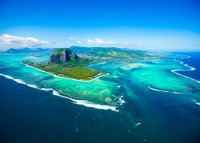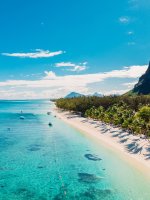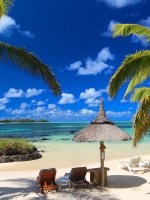Considering the large number of invasive exotic plants which have run rampant in Réunion, it is refreshing to note that one of these pests, the goyavier (Psidium cattleyanum), is actually extremely useful.
Introduced from eastern Brazil, the goyavier is a fairly nondescript shrub which grows to a height of 8m. Its deep red fruit somewhat resembles a miniature guava. It is an excellent source of vitamin C.
After being picked, the fruit tastes quite acidic, but innovative Réunionnais have found many uses for it.
For starters, goyavier cocktails are hallucinatory! Alternatively, try the exceedingly potent rum punch flavoured with it. Goyavier jam, too, is really tasty. So significant has this fruit become in Réunion, that there is even a two-day Goyavier festival, held every June in La Plaine-des-Palmistes.
Nobody who visits the lush montane forests in places such as Bébour-Bélouve, La Roche Ecrite, Cilaos (Plateau du Matrum), Salazie and Maïdo can fail to leave impressed. The same applies to the heathlands higher up, such as those of Brûlé de St-Paul, Maïdo and Grand Bénard, at about 1,600–2,400m.
Thanks to the inaccessibility of most of the interior uplands, large tracts of Réunion’s original forest still remain intact. The habitat types which have suffered most at the hands of man are lowland evergreen rainforests (everywhere, but especially in the eastern half) and the much drier scrub and woodlands of the west. Some 98,972ha of forest are under the care of the Office National des Forêts (ONF), which controls about 39% of Réunion. The French state presides over the coastal environment. The island’s only nature reserve is Mare Longue.
Réunion has some 700 indigenous plant species, of which 161 are endemic. There are several impressive botanical gardens around the island, where endemic and indigenous plants can be seen. At the Conservatoire Botanique Nationale deMascarin, above St-Leu, visitors can enjoy guided walks around the gardens with experienced botanists or ecologists
Commonly seen on the forest floor in humid places is the fern Marattia fraxinea. It is shared with Mauritius, Madagascar and the Comoros. Much more impressive is the tree fern Cyathea borbonica, which dominates the 5,146ha Bébour-Bélouve forest area. It attains a height of 10m and is also found in Mauritius. One bamboo, Nastus borbonicas, is endemic and easily identifiable by its papyrus-like clusters of leaves.
In dry western Réunion are two endemic succulents, although they aren’t common. The one you’re most likely to see is the aloe, Lomatophylum locrum, which bears yellow and dull-orange flowers.
There are many orchids endemic to the western Indian Ocean islands and, of these, some seven species are unique to Réunion. Most are now very rare. Indigenous orchids tend to have white blooms, with many flowering from December to March. Angraecum mauritanium is also found in Mauritius and, like other ‘comet’ orchids, it features a very long spur. Presumably, it is pollinated by hawk moths as other ‘comet’ (angrecoid) orchids are. Aeranthes arachnites is less showy and is shared with the other Mascarenes. The diminutive Bonniera appendiculata is extremely rare and endemic, with blooms shaped like a very thin starfish.
Some of the palms local to the Mascarenes are on the verge of extinction. An exception is the attractive Hyophorbe indica, endemic to Réunion. Today, it’s still quite plentiful. The same applies to the large, endemic ‘latanier rouge’ (Latania lontaroides), which has fan-shaped leaves with a distinct reddish hue. However, the ‘white palm’ (Dictosperma album, also found in Mauritius) is virtually extinct in the wild, because it is often used for heart of palm salad. That said, it has been cultivated very successfully.
Hibiscus are well represented in the Indian Ocean islands. Two rare species are unique to Réunion and Mauritius. Both are now protected. Hibiscus boryanus has scarlet or orange-red flowers, while those of H. columnarus are a bright yellow.
The shrub Ruizia cordata is possibly Réunion’s best-known endemic, because it is used as a ‘flagship’ species, to educate the public about the plight of endangered life forms. It is highly endangered and its silvery leaves are used in certain Tamil rituals. Unfortunately, researchers have not yet determined what the shrub’s pollinators are.
Foetidia mauritanium is an endemic hardwood used for construction. Its pungent wood is apparently not attacked by termites, hence its popularity, and as a consequence, its rarity. The silvery endemic tamarind, Acacia heterophylla, is abundant and it is the preferred wood for furniture production.
Two endangered shrubs – Pouzolia laevigata, used for treatment of fever, and Obetia ficifolia, which is shared with Rodrigues – are known to have their own, specific pollinator butterfly species. The extreme rarity of these shrubs means that their pollinator butterflies are also endangered.














